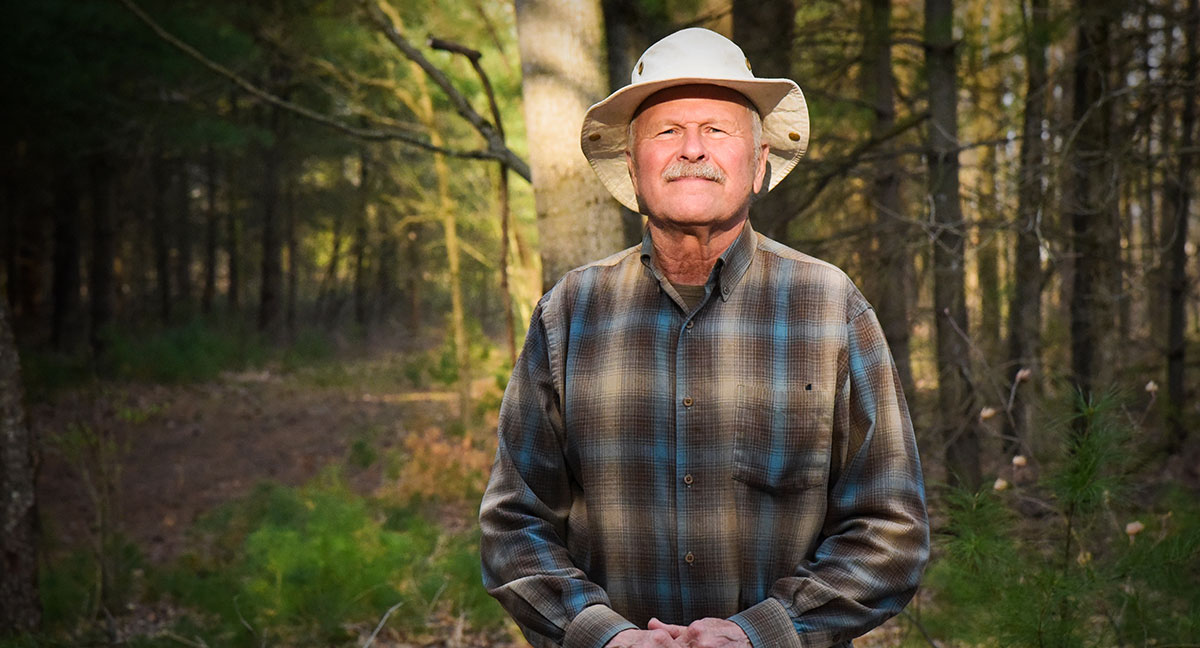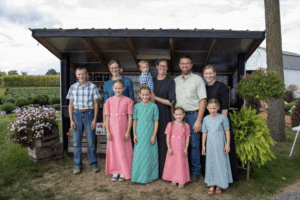On a spring morning filled with birdsong and crisp air, Bruce Wakeland stands beside a bench he built by hand and gazes across the land and waters he cherishes. Red-winged blackbirds flit through the cattails, frogs call from the shallows of the marsh, and wind stirs the willows like a soft lullaby.
“This,” he says, gesturing across the 129-acre Starke County Forest, “was once soybeans. Now it’s something better.”
What Bruce Wakeland has created — and given away — is a living classroom, a sanctuary for wildlife and a gift to the future. With deep knowledge and quiet humility, Wakeland has dedicated decades to transforming once-degraded farmland into a thriving hardwood forest. He’s done it with his own hands, guided by a philosophy of long-term stewardship. The forest, now owned by Starke County and open to the public, continues to grow under his watchful eye.
A professional forester with a degree from Purdue University, Wakeland has spent more than 50 years managing Indiana woodlands. His forestry work began in the late 1960s when he took a job marking timber for the state.
“In those days,” he recalls, “we didn’t always think in terms of wildlife habitat. But I started to notice what the animals needed. That changed the way I worked.”
Today, his understanding of ecosystems — how soil, water, light and life intertwine — guides every decision he makes.
Wakeland officially manages the forest and oversees the implementation of the Indiana Department of Natural Resources Forest Management Plan. Amie Flora, Starke County Parks superintendent, assists in coordinating the work and helps carry out his agenda with dedication and care.
Walking the trails with Wakeland is like stepping into a storybook where every tree has a tale and every bend in the path holds a lesson.
“Forestry is not logging,” he explains. “Logging is an act. Forestry is a process. A long one. It’s about knowing when to step in and when to let the forest do the work.”
He points out a stand of swamp white oaks, now 20 feet tall, that he planted nearly two decades ago.
“They’re just getting started,” he says with a smile.
The forest isn’t just a patch of trees — it’s a patchwork of ecosystems. Upland and lowland hardwoods stretch across gentle ridges. Vernal ponds, meadows and a shallow marsh provide habitat for amphibians, deer, turkeys, waterfowl, pollinators and migratory birds. Wakeland has created corridors between habitat zones to help wildlife travel safely. He uses controlled burns to manage invasive species and encourage native growth.
“We’re not trying to make it pretty,” he says. “We’re trying to make it right.”
Visitors enter from a gravel parking area just off Division Road in Starke County. The main trail leads through a hardwood grove with trees in every stage of life: some newly planted, others decades old. A modest wooden tower offers a peaceful view across the forest. Farther along the trail are the marsh, a sunny meadow and a pond where frogs sing from lily pads and dragonflies hover.
Whether you come to birdwatch, spot wildflowers, take a peaceful walk or simply breathe fresh air, the Starke County Forest welcomes you. Start your journey from the parking lot, follow the trail through groves of saplings and mature trees, climb the low observation tower, rest by the pond or stretch out in the meadow while birds sing overhead.
“This is about teaching,” Wakeland says. “We have to teach people what a healthy forest looks like, what it needs. Because if we don’t, we’ll lose it.”

He often hosts school groups, scouts and community members, answering questions with the patience of a grandfather and the precision of a scientist. His mission is clear: not just to preserve the forest, but to pass on the knowledge that made it possible.
Flora shares that vision.
“Bruce has made something extraordinary here,” she says. “And now we want more people to experience it. Especially kids. The more they learn, the more they’ll care.”
Plans are underway to expand educational programming, add new signage and improve accessibility, so the forest can inspire generations to come.
Wakeland is also a writer, sharing stories and environmental insights in essays he sometimes reads aloud at local venues like Wild Rose Moon. His words, like his woods, are shaped by time, care and a deep respect for the land.
“People think it’s about planting trees,” he says. “But really, it’s about planting ideas. Ideas that take root and grow.”
As we end our walk, Wakeland gestures toward a row of newly planted trees.
“These won’t mature for another 80 years,” he says. “I won’t be here. But someone will. And they’ll have shade. And birdsong. And beauty. That’s the point.”
He often quotes Senegalese forest ecologist Baba Dioum:
“In the end we will conserve only what we love. We will love only what we understand. And we will understand only what we are taught.”
Thanks to Bruce Wakeland — and the Starke County Forest he so lovingly tends — there is much to learn, much to love and much worth conserving.
To learn more, visit starkecountyparks.com.










